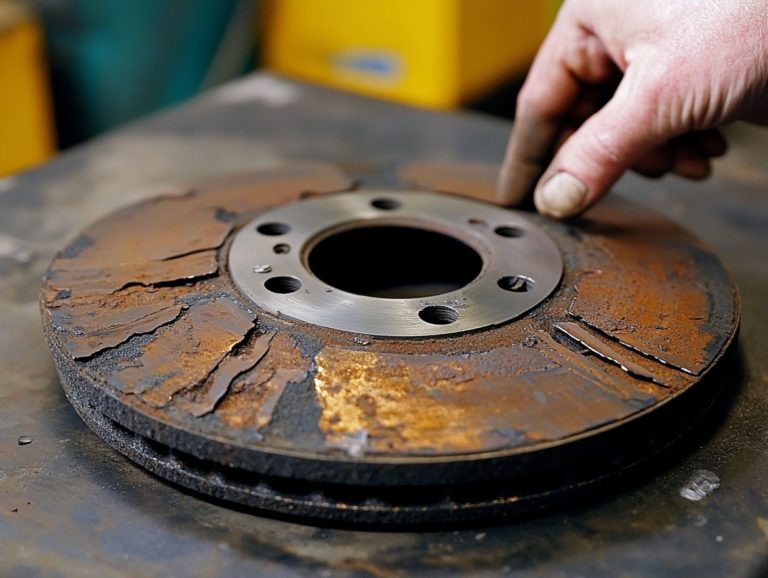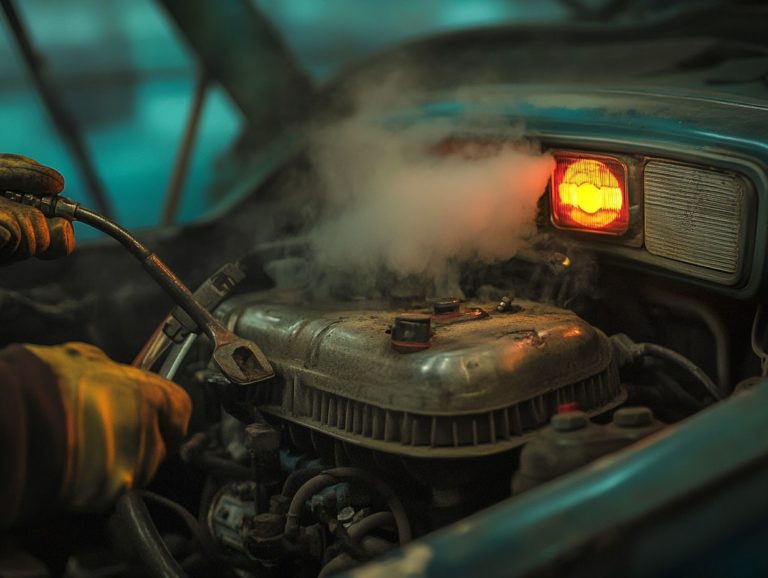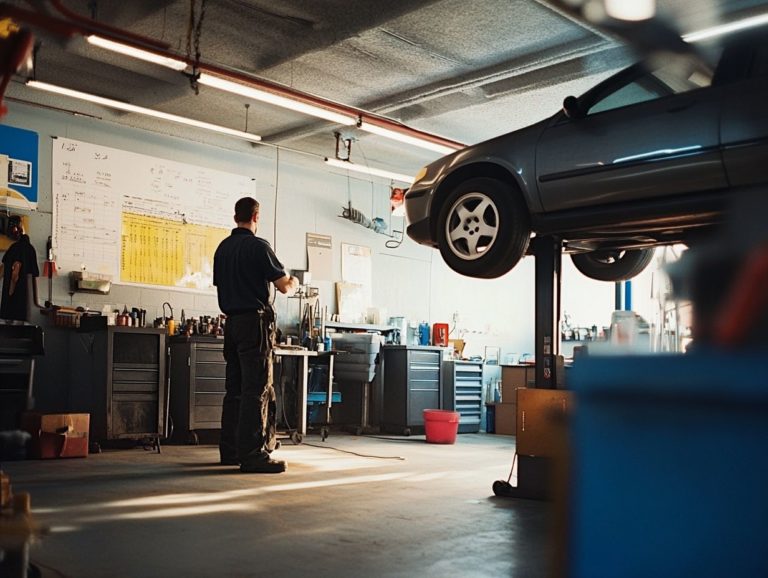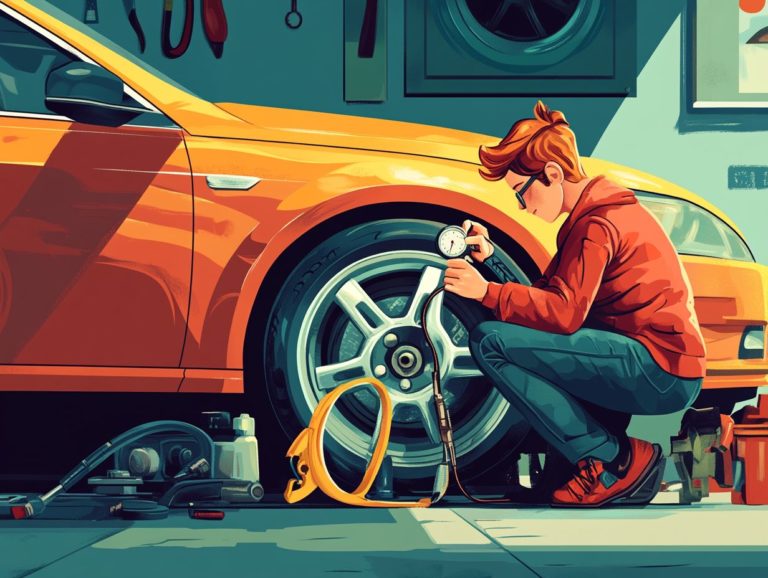What Are the Dangers of Ignoring Warning Lights?
Warning lights on your vehicle’s dashboard are vital indicators of your car’s health. They alert you to potential issues that could threaten safety and performance.
Understanding these signals is crucial for every driver. Neglecting them can lead to serious mechanical failures and costly repairs.
In this guide, you’ll discover the importance of warning lights, their meanings when they glow, and the preventive measures you can take to keep your vehicle running smoothly.
Stay informed! Keeping your vehicle in good health is essential!
Contents
- Key Takeaways:
- The Importance of Warning Lights
- Common Warning Lights and What They Indicate
- Possible Causes of Warning Lights
- What to Do When a Warning Light Appears
- Preventing Warning Lights from Appearing
- Frequently Asked Questions
- What Are the Dangers of Ignoring Warning Lights?
- What should I do if a warning light appears on my dashboard?
- Can ignoring a warning light lead to a breakdown?
- Are warning lights always a cause for concern?
- Can ignoring a warning light affect my car’s performance?
- Can ignoring a warning light result in costly repairs?
- Is it safe to drive with a warning light on?
Key Takeaways:

- Ignoring warning lights can lead to serious issues like accidents, vehicle damage, and high repair costs.
- Each warning light signals a specific problem that needs prompt attention to avoid further damage.
- Regular maintenance and addressing warning lights quickly can prevent hazards and save you time and money.
The Importance of Warning Lights
Warning lights are essential in modern vehicles, acting as early indicators of potential problems that can affect how well your vehicle runs and keeps you safe on the road.
These dashboard signals inform you about everything from minor maintenance needs to serious mechanical issues. It s vital to pay attention to them for effective vehicle care.
By understanding these alerts, you can prevent further damage and engage in proactive car care, ultimately protecting the integrity of your engine and other crucial parts.
Why Warning Lights Exist
Warning lights act as a proactive measure, informing you of potential issues that could compromise your safety and your vehicle’s performance.
These indicators serve as a communication tool between the complex systems of your vehicle and your understanding. They illuminate specific symbols on the dashboard, offering insights into different aspects of your vehicle’s health, such as how well your engine runs, tire pressure, and fluid levels. For example, when the check engine light comes on, it means you need to pay attention to something that may require immediate action.
In essence, these warning lights are crucial for maintaining safety on the road, empowering you to respond effectively to concerns before they turn into bigger problems.
Consequences of Ignoring Warning Lights
Ignoring warning lights can lead to various consequences, from minor issues evolving into major repairs to dangerous situations on the road.
When you overlook these critical indicators, you risk not only your vehicle’s performance but also your safety and that of others. Regular preventive maintenance is key to discovering underlying problems before they worsen. For instance, a simple coolant leak (a leak in the liquid that cools your engine) can turn into an overheated engine, leading to costly repairs and frustrating downtime.
By prioritizing prompt repairs and addressing warning signals without delay, you can ensure the longevity of your vehicle and maintain its optimal performance, preventing a series of problems that could have been easily avoided.
Common Warning Lights and What They Indicate
Common warning lights in vehicles are essential indicators of various systems, allowing you to monitor your vehicle’s health and prompting timely maintenance actions.
These signals are your vehicle’s way of communicating its needs, ensuring you remain informed and ready to take the necessary steps to keep everything running smoothly.
Understanding Different Warning Symbols

Understanding warning symbols is essential for drivers. These symbols help you know what your vehicle is trying to communicate through its dashboard lights.
They indicate potential maintenance issues and engine performance concerns. For instance, a battery alert symbol means there may be a charging problem and signals the need to check your car’s electrical system.
Similarly, the oil pressure light highlights the importance of monitoring engine lubrication. The tire pressure warning emphasizes the need to maintain optimal tire conditions for safety and efficiency.
By familiarizing yourself with these warning symbols, you can proactively address concerns, ensure reliable performance, and potentially avoid costly repairs down the line.
Possible Causes of Warning Lights
Warning lights can illuminate for many reasons. They often signal car problems that need your attention. It’s crucial to pay attention to these signals, as they could be early warnings of more significant issues.
Car Problems and Malfunctions
Car problems and malfunctions are key reasons warning lights appear, signaling that timely vehicle maintenance is essential.
These warning indicators act as vital alerts for various issues, from minor problems like low oil levels to major complications such as engine failures or transmission troubles.
Understanding the difference between minor and major car problems allows you to prioritize repairs effectively.
For example, a warning light for low tire pressure might just require a quick inspection and a top-up. However, signals related to the electrical system or an overheating engine demand immediate professional attention to prevent further damage.
Regular vehicle maintenance is invaluable in addressing these issues before they spiral out of control, ensuring you maintain both safety and reliability on the road.
What to Do When a Warning Light Appears
When a warning light illuminates on your dashboard, take action! It’s crucial to evaluate the situation and safeguard both your vehicle and its occupants. Your prompt attention can make all the difference in maintaining safety on the road.
Steps to Take and Precautions to Follow
It’s essential to take the right steps and precautions when a warning light appears. Your safety depends on it!
Stay calm and assess the situation methodically. Start by checking for additional symptoms, such as unusual noises or changes in performance, which could indicate more complex issues.
Next, consult your owner’s manual for insights specific to the warning light illuminated on your dashboard. It may hold crucial information about the necessary actions to take.
If uncertainties linger, prioritize a visit to an auto repair shop.
Remember, addressing warning lights promptly enhances your vehicle’s longevity and promotes safety on the road, underscoring the importance of preventive maintenance.
Preventing Warning Lights from Appearing
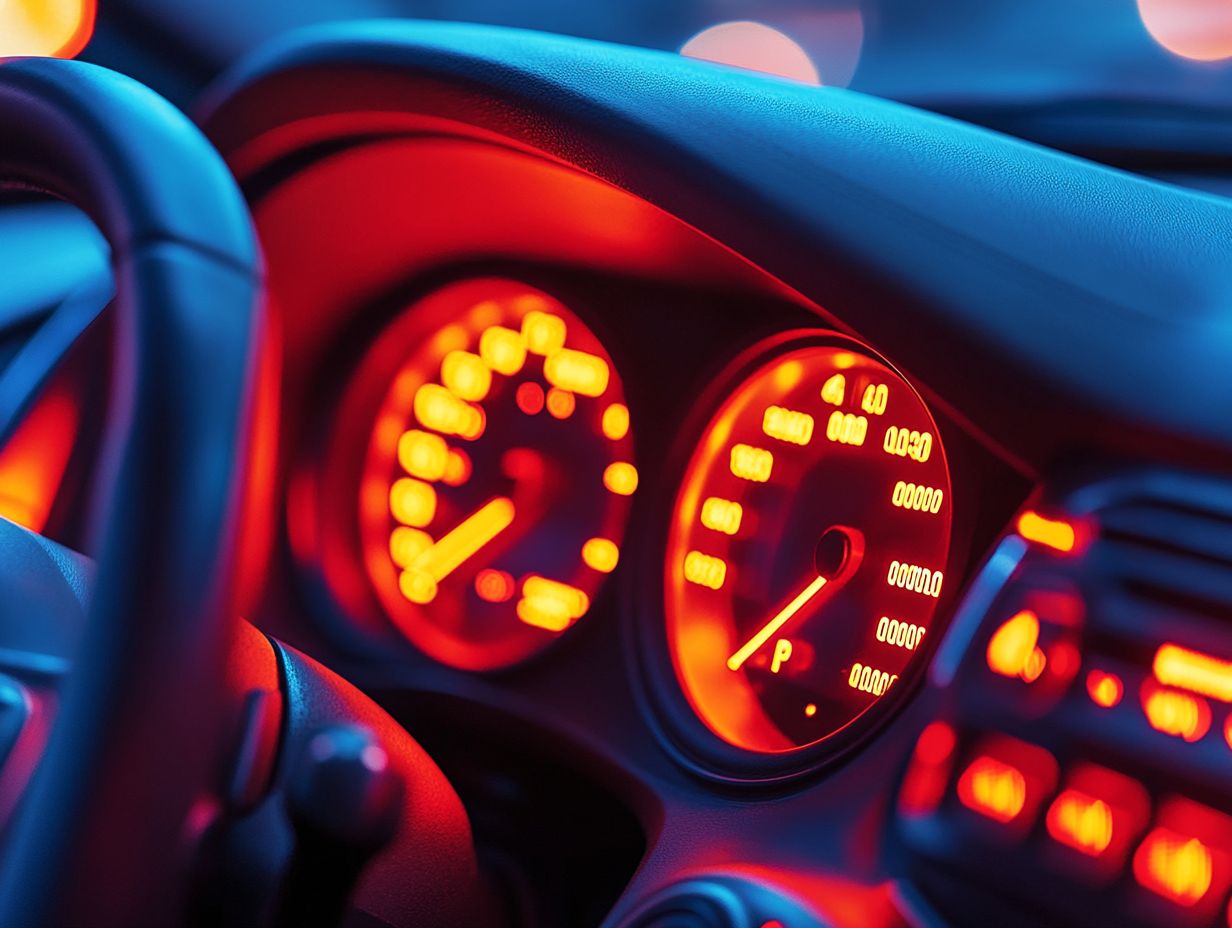
To prevent warning lights from illuminating on your dashboard, adopt a proactive approach to vehicle maintenance. By addressing minor issues promptly, you can effectively avert the escalation into more significant problems down the road.
Stay alert and take care of your vehicle!
Maintenance Tips and Best Practices
Follow these maintenance tips to avoid warning lights and enjoy a smooth ride! Implementing maintenance tips and best practices can significantly lessen the chances of warning lights appearing.
By routinely checking your fluid levels and tire pressure, you can tackle minor issues proactively. Keeping a detailed maintenance history helps you track services performed and serves as a valuable reference for future tune-ups.
Simple actions like changing the oil at regular intervals play a crucial role in extending your vehicle’s lifespan. Rotating your tires enhances both performance and safety on the road.
Frequently Asked Questions
What Are the Dangers of Ignoring Warning Lights?
Ignoring warning lights on your vehicle can have serious consequences. Here are six potential dangers:
- Engine damage
- Reduced vehicle performance
- Increased repair costs
- Safety hazards
- Loss of vehicle control
- Potential breakdowns
What should I do if a warning light appears on my dashboard?
Act quickly if a warning light pops up on your dashboard! Ignoring it can lead to bigger problems and potential dangers.
Can ignoring a warning light lead to a breakdown?
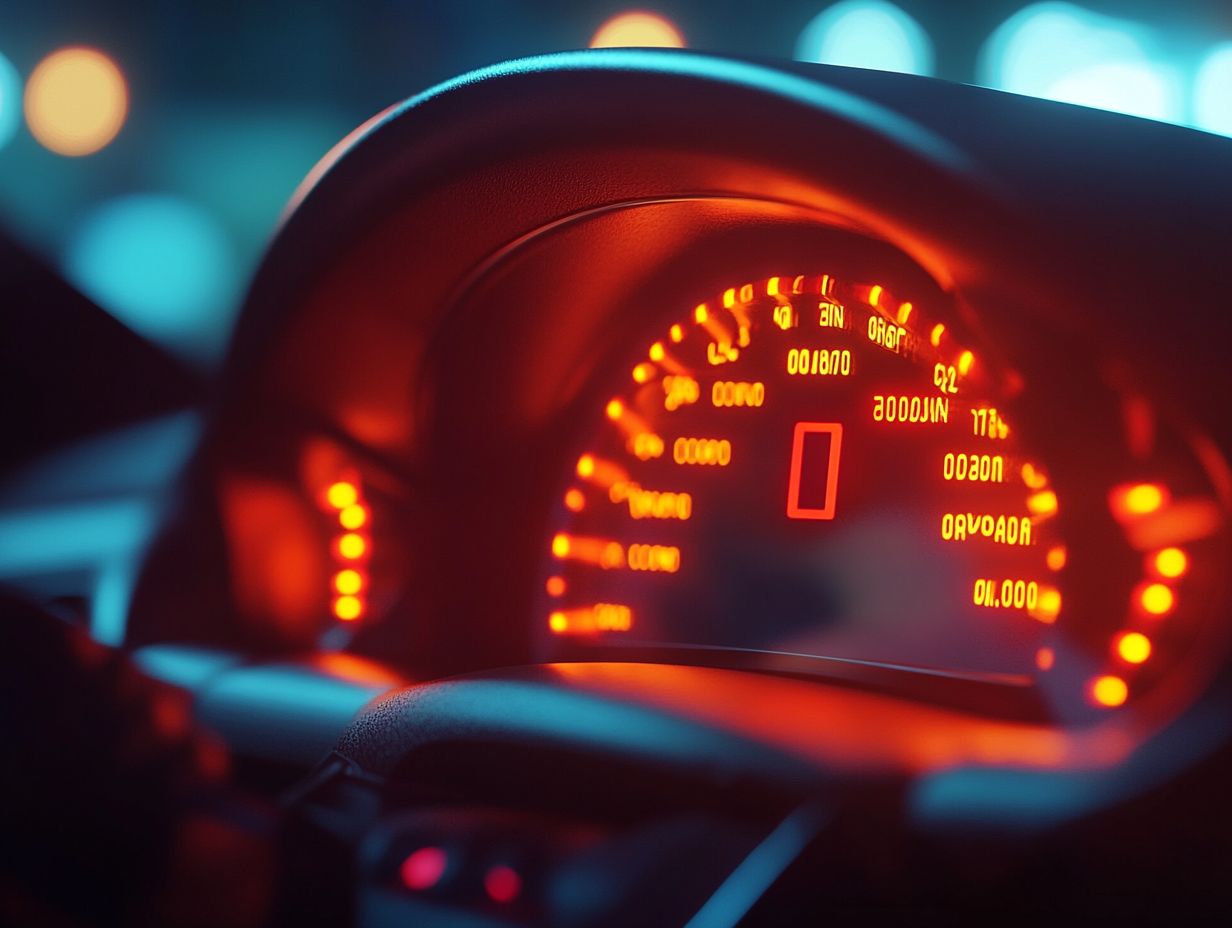
Yes, ignoring a warning light can eventually lead to a breakdown. The warning light signals a problem that needs addressing to prevent further damage.
Are warning lights always a cause for concern?
Yes, warning lights should always be taken seriously. They alert you of potential problems with your vehicle, and ignoring them can lead to safety hazards.
Can ignoring a warning light affect my car’s performance?
Ignoring a warning light can definitely affect your car’s performance. If the light indicates an issue with your engine or other vital components, it can lead to decreased performance and even engine damage if left unaddressed.
Can ignoring a warning light result in costly repairs?
Ignoring a warning light can potentially lead to more extensive and costly repairs down the road. Addressing the issue early on can save you money in the long run.
Is it safe to drive with a warning light on?
It is not recommended to drive with a warning light on, especially if it indicates a serious issue. Your safety and the safety of others on the road should always be a top priority.
Act now to keep your vehicle in top shape! Schedule a check-up with your mechanic to ensure your car runs smoothly and safely.

